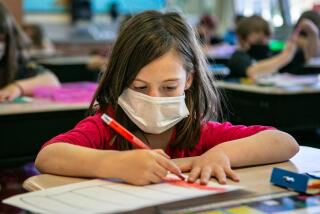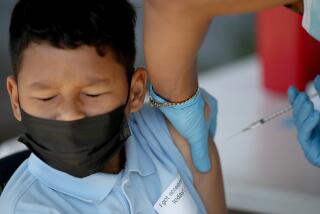AIDS ‘No Risk’ in Schools, U.S. Agency Finds
- Share via
WASHINGTON — The federal Centers for Disease Control, saying that “casual person-to-person contact, as would occur among schoolchildren, appears to pose no risk,” recommended Thursday that children suffering from AIDS in most cases should be permitted to attend regular classes.
“These children should be allowed to attend school and after-school day care, and to be placed in a foster home in an unrestricted setting,” the agency said, issuing guidelines for state and local health and education departments.
“None of the identified cases of (AIDS) infection in the United States are known to have been transmitted in the school, day care or foster care setting,” it added.
Eye Specialists Warned
In addition, the agency suggested precautions for eye-care practitioners so that they can avoid exposure to AIDS through the tears of infected patients.
The government made its recommendations on the same day that New York City school officials announced that they would bar students with AIDS, while the board of education in Plainfield, N. J., said that it is trying to decide whether to allow a 5-year-old girl with the disease to attend kindergarten.
Earlier this week, 13-year-old Ryan White of Kokomo, Ind., a hemophiliac who contracted AIDS through a blood transfusion, began listening to classes at home via a telephone hookup.
Dr. Martha Rogers, a medical epidemiologist with the Atlanta-based agency’s AIDS branch, said that the widespread attempts of school systems nationwide to forbid children with AIDS from attending classes had prompted the CDC to act.
“I don’t know of any situation where the diagnosis is known that a child has been allowed to go to school,” she said. “We felt this was an injustice to the children.”
She added: “People think all they have to do is come within 10 feet of someone and they will get it. What they don’t realize is that people are walking around with it every day.”
Although school systems are not required to follow the recommendations, Rogers said that she believes the CDC statements “will add a lot of weight to what all the states have already said.”
AIDS, or acquired immune deficiency syndrome, is an always-fatal disease caused by a virus that destroys the body’s immune system, leaving it vulnerable to otherwise rare infections. Of the 12,736 reported cases, 157 have been among children. A total of 108 children has died.
Sexual Contact Cited
In adults, the disease is transmitted through sexual contact, primarily through the exchange of bodily fluids, or through blood transfusions. Those at highest risk include male homosexuals and bisexuals, intravenous drug users and their steady sexual partners. The majority of infected children acquired the virus from infected mothers during pregnancy or through the transfusion of blood or blood products.
“It is not a very transmissable illness,” Rogers said. “In fact, an AIDS child . . . is at more risk (from infection) in the classroom than a non-AIDS child.”
The CDC guidelines said that exceptions could be made in the case of some preschool or neurologically handicapped children “who lack control of their body secretions or who display behavior such as biting,” as well as for children who have “uncoverable, oozing lesions.” For those children, CDC said, “a more restricted environment is advisable.”
The agency recommended also that all schools and day care facilities adopt routine procedures for handling blood or body fluids, regardless of whether infected children are in attendance. It suggested that soiled surfaces be cleaned with disinfectants and that disposable towels or tissues be used.
“Those who are cleaning should avoid exposure of open skin lesions or mucous membranes to the blood or body fluids,” the CDC said.
Respect for Privacy Urged
The agency urged school officials to “respect the child’s right to privacy, including confidential records,” and suggested that the number of personnel aware of the child’s condition “be kept at a minimum needed to assure proper care of the child and to detect situations where the potential for transmission may increase,” such as a bleeding injury.
Meanwhile, the CDC recommended that eye-care practitioners wash their hands after each procedure and between the times that they see patients.
“Hand washing alone should be sufficient but, when practical and convenient, disposable gloves should be worn,” the agency said. “The use of gloves is advisable when there are cuts, scratches or (skin) lesions on the hands. The use of other protective measures, such as masks, goggles or gowns is not indicated.”
More to Read
Sign up for Essential California
The most important California stories and recommendations in your inbox every morning.
You may occasionally receive promotional content from the Los Angeles Times.










